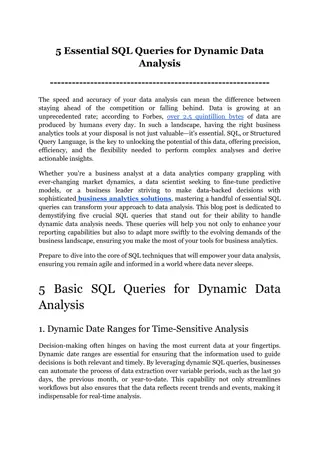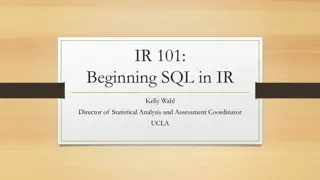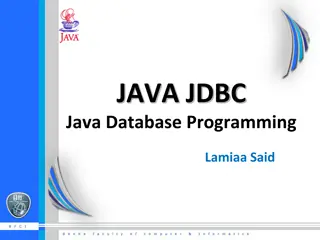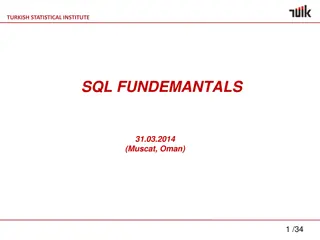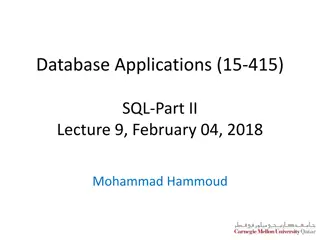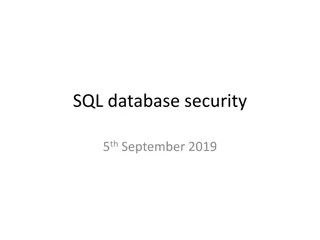
Advanced SQL Queries for Database Information Retrieval
Learn how to query multiple tables using advanced SQL techniques, combining data from different sources to retrieve specific information such as customer orders and products purchased. Explore inner joins and syntax for joining tables effectively in database querying.
Download Presentation

Please find below an Image/Link to download the presentation.
The content on the website is provided AS IS for your information and personal use only. It may not be sold, licensed, or shared on other websites without obtaining consent from the author. If you encounter any issues during the download, it is possible that the publisher has removed the file from their server.
You are allowed to download the files provided on this website for personal or commercial use, subject to the condition that they are used lawfully. All files are the property of their respective owners.
The content on the website is provided AS IS for your information and personal use only. It may not be sold, licensed, or shared on other websites without obtaining consent from the author.
E N D
Presentation Transcript
MIS2502: Data and Analytics SQL Getting Information Out of a Database Part 2: Advanced Queries Jeremy Shafer jeremy@temple.edu http://community.mis.temple.edu/jshafer
Querying multiple tables Right now, you can answer with data from a single table What if you need to combine two (or more) tables? For example, what if we want to find out the orders a customer placed?
The (Inner) Join We ve seen this before Order Table Customer Table `Order` Number OrderDate Customer ID Customer ID FirstName LastName City State Zip 101 2011-3-2 1001 1001 Greg House Princeton NJ 09120 102 2011-3-3 1002 1002 Lisa Cuddy Plainsboro NJ 09123 103 2011-3-4 1001 1001 Greg House Princeton NJ 09120 104 2011-3-6 1004 1004 Eric Foreman Warminster PA 19111 We matched the Order and Customer tables based on the common field (CustomerID) We can construct a SQL query to do this
Joining tables Syntax : SELECT column_name(s) FROM schema_name.table_name1 JOIN schema_name.table_name2 ON table_name1.column = table_name2.column; Example : SELECT * FROM orderdb.Customer JOIN orderdb.Order ON Customer.CustomerID=Order.CustomerID; Returns this: Customer. CustomerID Order Number Order. CustomerID FirstName LastName City State Zip OrderDate 1001 Greg House Princeton NJ 09120 101 2011-3-2 1001 1002 Lisa Cuddy Plainsboro NJ 09123 102 2011-3-3 1002 1001 Greg House Princeton NJ 09120 103 2011-3-4 1001 1004 Eric Foreman Warminster PA 19111 104 2011-3-6 1004
A closer look at the JOIN syntax SELECT * FROM orderdb.Customer JOIN orderdb.Order ON Customer.CustomerID=Order.CustomerID; SELECT * Return all the columns from both tables FROM orderdb.Customer JOIN orderdb.Order The two tables to be joined ON Customer.CustomerID = Order.CustomerID Only choose records where the CustomerID exists in both tables Another way to say it: Choose customers that have placed an order The . notation is table_name.column_name We need this when two tables have the same column name.
A more complex join Question: What products did each customer order? Goal: We ultimately want this view of the database OrderNumber FirstName LastName ProductName Quantity Price 101 Greg House Cheerios 2 3.99 101 Greg House Bananas 3 1.29 101 Greg House Eggo Waffles 1 2.99 102 Lisa Cuddy Cheerios 5 3.99 102 Lisa Cuddy Bananas 2 1.29 103 Greg House Eggo Waffles 3 2.99 104 Eric Foreman Eggo Waffles 8 2.99
How to do it? We need information from Customer and Product (and OrderProduct) To associate Customer table with Product table, we need to follow the path from Customer to Product
Heres the query SELECT Order.OrderNumber, Customer.FirstName, Customer.LastName, Product.ProductName, OrderProduct.Quantity, Product.Price FROM orderdb.Customer JOIN orderdb.Order ON Customer.CustomerID=Order.CustomerID JOIN orderdb.OrderProduct ON Order.OrderNumber=OrderProduct.OrderNumber JOIN orderdb.Product ON Product.ProductID=OrderProduct.ProductID; It looks more complicated than it actually is! Note that we have three join statements.
Now there are endless variations Question: What is the total number of products bought by the customer Greg House ? SELECT SUM(OrderProduct.Quantity) FROM orderdb.Customer JOIN orderdb.Order ON Customer.CustomerID=Order.CustomerID JOIN orderdb.OrderProduct ON Order.OrderNumber=OrderProduct.OrderNumber JOIN orderdb.Product ON Product.ProductID=OrderProduct.ProductID WHERE FirstName= Greg AND LastName = House ; Answer:11
Consider another example Question: Get a full list of ALL customers and their orders information Goal: This is the view of the database we want Customer. CustomerID Order Number Order. CustomerID FirstName LastName City State Zip OrderDate 1001 Greg House Princeton NJ 09120 101 2011-3-2 1001 1002 Lisa Cuddy Plainsboro NJ 09123 102 2011-3-3 1002 1001 Greg House Princeton NJ 09120 103 2011-3-4 1001 1004 Eric Foreman Warminster PA 19111 104 2011-3-6 1004 James Wilson Pittsgrove NJ 09121 1003 NULL NULL NULL James has no orders!
Outer Join We need another operator for the item that have a match, it behaves like a Join, but for the items that have NO MATCH, it appends the record with NULLs The operators with these properties are called outer joins. (There are several of them) The operators that we studied already are also called inner joins(To distinguish them from outer joins) reference: www.dofactory.com/sql/join
Left Join Syntax : SELECT column_name(s) FROM schema_name.left_table_name LEFT JOIN schema_name.right_table_name ON left_table_name.column = right_table_name.column; (INNER) JOIN: Select records that have matching values in both tables. LEFT (OUTER) JOIN: Select records from the first (left-most) table with matching right table records.
Joining tables using Left Join SELECT * FROM orderdb.Customer LEFT JOIN orderdb.Order ON Customer.CustomerID=Order.CustomerID; Returns this: Customer. CustomerID Order Number Order. CustomerID FirstName LastName City State Zip OrderDate 1001 Greg House Princeton NJ 09120 101 2011-3-2 1001 1002 Lisa Cuddy Plainsboro NJ 09123 102 2011-3-3 1002 1001 Greg House Princeton NJ 09120 103 2011-3-4 1001 1004 Eric Foreman Warminster PA 19111 104 2011-3-6 1004 James Wilson Pittsgrove NJ 09121 1003 NULL NULL NULL James has no orders! But we still want his name in the list
Another example Question: How many orders does each customer have? Start with this: SELECT *FROM Orderdb.Customer LEFT JOIN Orderdb.Order ON Customer.CustomerID=Order.CustomerID; Customer. CustomerID Order Number Order. CustomerID FirstName LastName City State Zip OrderDate 1001 Greg House Princeton NJ 09120 101 2011-3-2 1001 1002 Lisa Cuddy Plainsboro NJ 09123 102 2011-3-3 1002 1001 Greg House Princeton NJ 09120 103 2011-3-4 1001 1004 Eric Foreman Warminster PA 19111 104 2011-3-6 1004 James Wilson Pittsgrove NJ 09121 1003 NULL NULL NULL
Then Question: How many orders does each customer have? SELECT Customer.customerID, Count(ordernumber) FROM Orderdb.Customer LEFT JOIN Orderdb.Order ON Customer.CustomerID=Order.CustomerID GROUP BY CustomerID; Answer: CustomerID Count(ordernumber) Here, we use Count(ordernumber) not Count(*). Why? 1001 2 1002 1 1003 0 1004 1 James (1003) has no orders
Summary Given a schema of a database, we now should be able to create a SQL statement (query) to answer a question Understand how to use SELECT FROM DISTINCT WHERE (and how to specify conditions) AND/OR ORDER BY (ASC/DESC) Functions: COUNT, AVG, MIN, MAX, SUM GROUP BY LIMIT Joins (and differences between inner/outer join)


